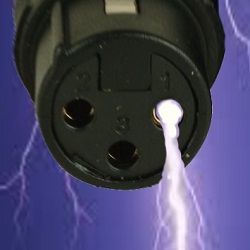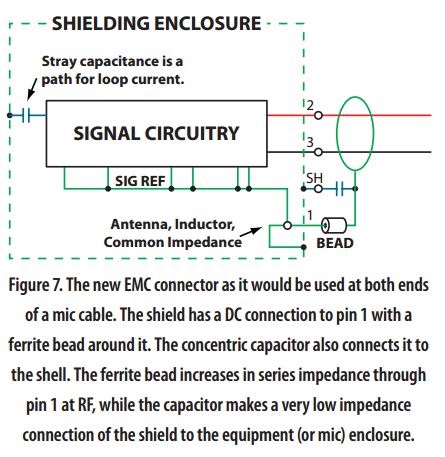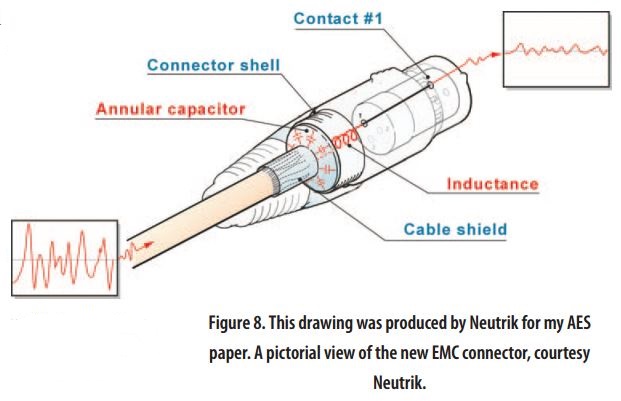
Engineer Joanne Dow observed that if such a connector were to be used with a connection to pin 1, the capacitor and the series inductance to the chassis through pin 1 would form a parallel resonance, and suggested a ferrite bead surrounding pin 1 in the cable connector to lower the Q of the resonance.
It took a while for these ideas to germinate, but before long, engineers at Neutrik had begun work on a practical implementation (Figure 8), and by early 2002 had developed engineering prototypes. British consultant John Woodgate tested them in his lab, and I tested them both in my lab and in the field. The results met my expectations, and yielded an unexpected bonus—they solved RF pin 1 problems, even when pin 1 was connected at both ends!
A simple circuit study shows why.
Figure 7 shows a cable using the new connectors used with the mic shown in Figure 5.
The concentric capacitor ties the shield to the mic shell with an inductance that is much lower than the wire inside the mic.
Not only that, but the ferrite bead around pin 1 inside the new connector adds series impedance to the path through pin 1, effectively disconnecting the shield from the pin 1 problem.
Shield current thus divides, most of it taking the low impedance path through the capacitance to the shell, with very little flowing through pin 1. In effect, the new connector bypasses the problem!
But even this well engineered solution cannot be effective if mating connector shells don’t make good contact, or if the equipment connector shell is not bonded to the enclosure. I own a portable DAT machine that has a massive pin 1 problem, so much so that when it’s used with its own preamp with a dynamic mic in downtown Chicago the detected FM and TV stations are nearly as loud as an interviewer a foot from the mic.
The new EMC connector completely eliminates the detected RF—if I carefully push against the side of the connector to force the connector shells to make contact. But without that pressure, the shells can lose contact and the RF interference returns! And the new connector doesn’t help a popular mixer with a serious RF pin 1 problem, because the equipment connector shell is not connected to the enclosure!
Now that I’ve been alerted to them, these connector shell mating problems are turning out to be more prevalent than any of us would have suspected. It appears not to be limited to the use of off-brand or pirated connectors—it shows up on connectors that have been verified to have come from the same manufacturer! I’ve also seen it in connectors built into very good quality preamps and mics from a variety of manufacturers. So far, the list includes Audio-Technica, Mackie, Neumann, Sound Devices, and Tascam.
References
1. Neil A. Muncy, “Noise Susceptibility in Analog and Digital Signal Processing Systems,” presented at the 97th AES Convention of the Audio Engineering Society in San Francisco, CA, Nov. 1994.
2. Syn-Aud-Con.
Download the original article as a PDF here.
Jim Brown is the (retired) principal consultant of Audio Systems Group, a small consulting firm specializing in the design of sound systems for public spaces – theaters, churches, stadiums, jazz clubs.


